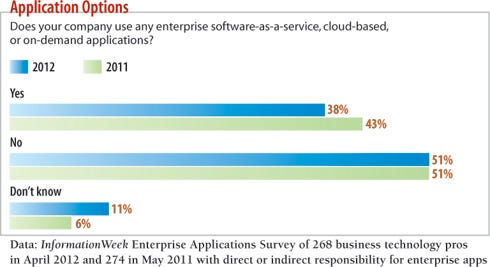Enterprise Applications: Customization Vs. ConfigurationEnterprise Applications: Customization Vs. Configuration
One way businesses are coping with the challenge of upgrading and optimizing enterprise apps is to avoid customization. But configuration options present challenges of their own.

Get the full report on the 2012 Enterprise Application Survey
>> See all of our reports <<
We've been asking information readers about their attitudes toward enterprise applications since 2010, and over the years we've seen remarkably consistent responses to certain questions. One area that's an ongoing source of pain is changing, upgrading, or optimizing existing applications. That was by far the top barrier to success in application and process management cited by respondents to our 2012 Enterprise Applications Survey, and those results were much the same in our 2011 and 2010 polls. These tasks were also cited as the most time-consuming ones respondents face, and here, too, results were nearly identical in 2011 and 2010.
One way businesses are coping with the challenge of upgrading and optimizing enterprise applications is to avoid customization. For their part, vendors are providing more options to configure applications for particular needs and industries. But in some cases, configuration options are getting so numerous and layered that they present challenges of their own
The difference between customization and configuration boils down to coding and development versus a vendor-supplied menu- or wizard-driven approach. When you develop custom code to change or extend functionality, there's always a chance the code won't work when the vendor introduces the next release, so extra validation steps are required. In the case of major upgrades, customization can be just as demanding and time-consuming as migrating to a whole new application, as broken functionality may have to be redeveloped from scratch.
As a result, some companies hold off on upgrades, weighing the benefits of new features against the pain of fixing broken customizations. In response, on-premises software vendors are increasingly embracing configuration, an approach used heavily in the software-as-a-service world, but IT shops used to the old way might be tempted to customize.
A better bet might be the cornerstone of the application strategy at Zebra Technologies, a supplier of bar code, receipt, kiosk, ID card, and RFID hardware and software. To wit: Avoid customization at all costs, a game plan that came about fairly recently. Until 2009, Zebra had 140 heavily customized legacy systems that didn't communicate well, says CIO Don O'Shea. That lineup included eight different Baan (now Infor) ERP deployments. When software broke or had to be upgraded, Zebra's own IT staff did the debugging and redeveloping, which stole attention from other projects. "In the old model, 80% of our staff time was dedicated to production support," O'Shea says. "Now 80% of the work is on new projects that bring value to the business."
That's an impressive flip. To get there, the company undertook a massive three-year rationalization and migration project that involved moves to Oracle E-Business Suite ERP, Siebel CRM, Oracle Advanced Supply Chain Planning, and Oracle Demantra demand planning software, along with Oracle Fusion Middleware and Oracle BI and performance management software.
The key has been having the discipline not to customize, O'Shea says. It might be tempting to add a few lines of code here and a handy gadget there, but customizations have a way of multiplying and adding up to trouble, particularly during upgrade cycles.
"We've lowered our support cost internally, and we're taking maximum advantage of Oracle support," O'Shea says, noting that there's never a question about the source of a problem. "We log a ticket and provide the details to Oracle support, and we get the fix back in a patch."
BARRIERS TO SUCCESS
What are your company's biggest application or process management-related impediments?
49% Changing, upgrading, or optimizing applications 32% Changing or adapting processes as business requirements change 30% Implementing new applications 17% Automating or integrating business processes Data: information 2012 Enterprise Application Survey of 338 business technology professionals
Configuration Conundrum
Even where it makes sense to steer clear of customization, using vendor-supplied configuration tools isn't always a simple alternative. These utilities get down into the nitty-gritty of how a company runs its business: Do you handle inventory tracking on a first-in, first-out or a last-in, first-out basis? How do you handle payment terms? What are your currency codes, tax-reporting approaches, and the details of your chart of accounts?
Vendors tout their wizard-driven configurations, but there's no getting around the depth and detail required in an initial deployment. Expect plenty of fill-in-the-blank parameters, data-element names, target destinations, and obscure and inscrutable settings.
Those who think configuration is a cake walk are "wearing rose-colored glasses," says Mike Cuddy, CIO of Canadian heavy-equipment supplier Toromont Industries. Toromont runs SAP ERP and has a couple of employees with SAP configuration knowledge on staff, but they quickly get outside their areas of expertise when unfamiliar modules are introduced, Cuddy says. You need specialized and highly trained people to know which switches to switch, the rules required, and the implications for downstream processes--skills rare in Ontario, he says.
"When we look for help locally, we often can't find it, or there might be one person available, and they won't know everything we'd like them to know," he says.
So despite the fact that vendors and companies alike are embracing configuration over customization, it's unlikely that will do much to alter IT pros' perceptions of the difficulties involved in changing and optimizing apps, as indicated by our survey.
Once properly configured, applications should be much easier to upgrade and support, but the one-time configuration challenge "is a long way from download and type in 'setup.exe,'" says Cuddy.
Case For Custom
For some businesses, customization is part of how they differentiate themselves. A prime example is Nissin Foods U.S.A., one of 36 subsidiaries of global Japanese food company Nissin Foods. Nissin USA has customized its Microsoft Dynamics NAV ERP implementation to handle trade promotions, electronic data interchange, supply chain management, and manufacturing resource planning tasks that are unique to the industry and the way it works.
"As a food manufacturer, we're picky about everything, and we couldn't find anything off the shelf that fulfilled our needs," says Ruben Haritoonian, head of MIS and IT. Working with systems integrator Deloitte, Nissin considered SAP, Oracle JD Edwards, and a few other ERP options before settling on Dynamics NAV. The selling point: "It's highly customizable," Haritoonian says.
With customization, Nissin was able to retire a $1 million legacy trade promotion software package, and within two years, it paid for the custom work with the money it saved on software maintenance of the legacy system, Haritoonian says.
We also hear some IT pros say that cloud-based apps and customization just don't go together, but that's a myth, says Stephen Baumer, CTO at GoPro, a maker of wearable and gear-mountable sports cameras. GoPro, which runs its IT operations almost entirely in the cloud, has done multiple customizations of its NetSuite ERP, e-commerce, order management, asset management, inventory tracking, and CRM applications, Baumer says. NetSuite provides SuiteBuilder customization tools and a SuiteFlow workflow engine. To change functionality that those tools don't expose, you can "open up the hood and customize at a deeper layer with JavaScript," he says.
In its most complex customization, GoPro didn't want to use NetSuite's standard functionality for credit holds and credit limits, so it developed and inserted its own algorithms by uploading a one-page JavaScript file into the library associated with GoPro's instance of NetSuite.
So what happens when NetSuite rolls out its next upgrade?
"NetSuite gives us advanced warning that there's going to be an upgrade, and we have 2-1/2 months to validate all of our scripts in a test environment," Baumer says.
Having a limited number of scripts and a single customization is one thing, but does the list of customizations inevitably get out of hand, as it can in the on-premises world? "We're probably getting to that point, to be honest," Baumer says, noting that GoPro has about 25 customizations, though most are tiny, three-line code changes, he says.
Sometimes the company doesn't even get around to testing the customizations, yet it has never run into a major problem in the wake of a NetSuite upgrade, Baumer says. "NetSuite is conscious of the code that's out there, and they don't usually make changes in a way that makes scripts break," he says.
Reconsider Your Methods
For SaaS and on-premises software vendors alike, configuration is now the favored approach for letting customers tweak application functionality. It's also used to add industry-specific features. In some cases, vendors make a point of spotting often-customized features and functions and making them more flexible through configuration settings.
While all IT teams try to seek out the enterprise applications (particularly deep ERP systems) that best fit their needs out of the box, the reality is that the business may still need some level of customization. With that in mind, explore the depth and breadth of options: What can be done without customization, and what development tools, APIs, source code, partner resources, and support options are available if you do need to customize?
If, at first blush, a business requirement doesn't appear to fit with out-of-the-box capabilities, have the discipline to ensure that requirements are well documented and thoroughly understood. In fact, Eric Kimberling, an ERP expert and president of Panorama Consulting, advocates a thorough cost-benefit analysis before writing a single line of code. "Ensure that you're only customizing where it provides the company with a unique competitive advantage and where there's no viable workaround within the system," Kimberling says. Otherwise, you may be committing your IT team to supporting custom software--keeping the lights on, that is--for the long term and for no good reason.


information: August 13, 2012 Issue
Download a free PDF of information magazine
(registration required)
About the Author
You May Also Like






